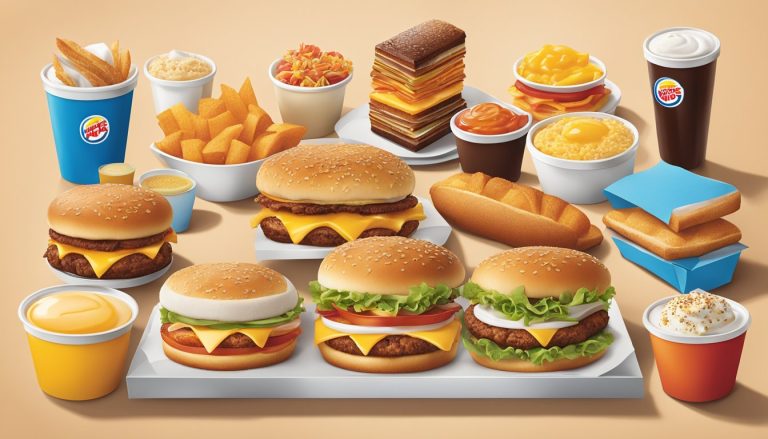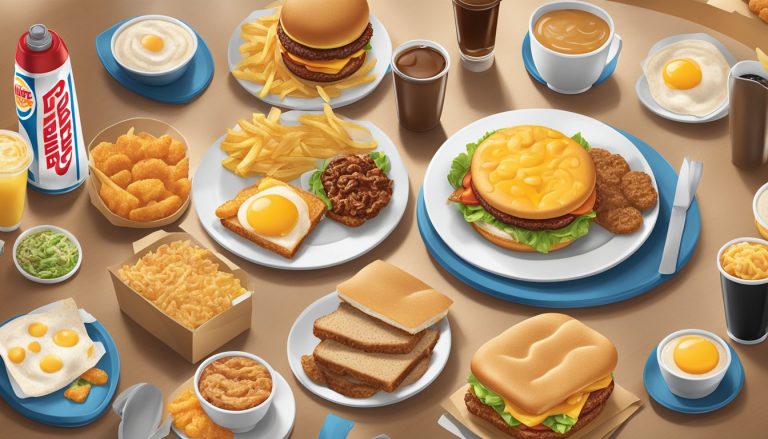Burger King’s breakfast menu has become a staple for many Americans seeking a quick morning meal. Since its introduction in the 1970s, BK’s breakfast offerings have evolved to cater to changing tastes and preferences. The menu now includes a variety of options, from traditional egg sandwiches to more innovative items like breakfast burritos and maple waffle sandwiches.
BK’s breakfast menu reflects broader shifts in American eating habits, with a growing demand for convenience, portability, and indulgence in morning meals. The popularity of items like the Croissan’wich and breakfast burrito demonstrates how fast food chains have adapted to meet these changing preferences. These handheld options allow consumers to enjoy a hearty breakfast on-the-go, aligning with the fast-paced lifestyle of many Americans.
The evolution of BK’s breakfast menu also showcases the American palate’s increasing acceptance of diverse flavors and ingredient combinations. From spicy sauces in breakfast burritos to the sweet and savory mix of maple waffles with eggs and sausage, these offerings cater to more adventurous taste buds. This trend mirrors the broader culinary landscape in the United States, where fusion cuisine and bold flavor profiles have gained widespread appeal.
The Rise of Burger King’s Breakfast

Burger King’s entry into the breakfast market marked a significant shift in fast food offerings. The chain expanded its menu to capture the growing morning customer base, introducing innovative items tailored to American tastes.
Historical Context
Burger King launched its breakfast menu in the late 1970s, following McDonald’s lead in tapping into the morning crowd. Fast food breakfast was a relatively new concept at the time, with chains recognizing the potential of serving early risers.
Burger King’s initial breakfast offerings were simple, designed to compete with traditional breakfast fare. The chain focused on creating portable, convenient options for customers on the go.
As consumer habits evolved, Burger King adapted its breakfast strategy to meet changing demands. The 1980s and 1990s saw an expansion of their morning menu, with new items added to attract a wider audience.
Innovation in Breakfast Menu Offerings
Burger King’s breakfast innovation centered around the Croissan’wich, introduced in the 1980s. This signature item combined a buttery croissant with savory fillings, offering a unique alternative to standard breakfast sandwiches.
The chain continued to diversify its menu with options like:
- Pancake platters
- Breakfast burritos
- French toast sticks
Burger King also focused on value, introducing competitive pricing and combo meals to attract cost-conscious consumers. The chain regularly updates its breakfast menu, balancing classic favorites with new creations to keep customers interested.
Recent years have seen Burger King experimenting with bolder flavors and larger portion sizes, reflecting evolving American taste preferences. The chain has also embraced healthier options, adding items with reduced calorie counts to appeal to health-conscious diners.
Key Components of BK’s Breakfast

Burger King’s breakfast menu offers a variety of savory and sweet options designed to cater to diverse tastes. The menu features customizable choices that allow customers to tailor their meals to their preferences.
Savory Selections
Burger King’s savory breakfast items form the cornerstone of their morning offerings. The Croissan’wich stands out as a signature item, combining flaky croissant dough with eggs, cheese, and a choice of meat. Customers can opt for bacon, sausage, or ham in their sandwich.
The breakfast sandwiches extend beyond the Croissan’wich. BK offers biscuit sandwiches and the Double Sausage Breakfast Sourdough King for those seeking heartier options. These sandwiches typically include eggs and American cheese.
For those looking to customize their protein intake, Burger King provides options to double up on meat or add extra eggs to most sandwiches.
Sweet Breakfast Treats
BK caters to those with a sweet tooth through various menu items. French Toast Sticks serve as a popular choice, offering a handheld twist on the classic breakfast dish. These golden-brown sticks come with a side of syrup for dipping.
Pancakes also feature on the menu, often paired with savory items like sausage to create a balanced meal. The combination of sweet and savory flavors appeals to customers seeking a more traditional American breakfast experience.
BK occasionally introduces limited-time sweet offerings to keep the menu fresh and exciting for regular patrons.
Customizable Options
Burger King emphasizes customization in its breakfast menu. Customers can mix and match items to create their ideal meal. The ability to add or remove ingredients from sandwiches allows for personalization based on dietary preferences or restrictions.
Side options like hash browns complement the main dishes. Beverage choices range from coffee to orange juice, with the option to upsize for those needing an extra caffeine boost.
BK also offers breakfast platters for customers desiring a full spread. These typically include a combination of eggs, meat, and bread items, providing a comprehensive breakfast experience.
Nutritional Considerations

Analyzing the nutritional content of Burger King’s breakfast menu reveals key insights about calorie counts, macronutrients, and healthier options. This information helps consumers make informed choices aligned with their dietary goals.
Understanding Nutritional Information
Burger King provides detailed nutritional data for all breakfast items. This includes calories, fat, carbohydrates, protein, sodium, and other key nutrients. Calories range from around 140 for a plain English muffin to over 700 for some breakfast sandwiches.
Fat content varies widely, with items like the Egg-Normous Burrito containing 43 grams. Sodium levels are generally high across the menu. Many breakfast items exceed 1000mg of sodium, which is nearly half the recommended daily limit.
Protein content is substantial in egg-based items. The Ultimate Breakfast Platter offers 32 grams of protein. Carbohydrate levels are typically high due to breads and hash browns.
Comparing Breakfast Items
Value menu options like hash browns or a sausage biscuit provide affordable choices but are often high in calories and fat. The Croissan’wich line ranges from 340 to 610 calories, depending on ingredients.
Breakfast sandwiches with egg whites offer lower-calorie alternatives. The Egg White and Turkey Sausage Wake-Up Wrap contains 240 calories and 11 grams of fat.
Pancakes and French toast sticks are carbohydrate-heavy choices. A 3-piece French toast stick order has 230 calories and 44 grams of carbs.
Breakfast burritos are among the most calorie-dense items. The Egg-Normous Burrito packs 910 calories and 55 grams of fat.
Health-Conscious Choices
For those watching their calorie intake, egg-based items without meat or cheese are good options. An Egg and Cheese Croissan’wich has 340 calories compared to 610 for its sausage counterpart.
Oatmeal is a healthier alternative, providing fiber and lower calories. BK’s Quaker Oatmeal contains 170-270 calories depending on toppings.
Fruit options are limited but can add nutritional value. Apple slices are available as a side, offering vitamins and fiber with only 30 calories.
Choosing water or unsweetened coffee instead of sugary drinks can significantly reduce calorie intake. A small sweet tea adds 89 calories to a meal.
Catering to the Morning Rush
Fast food chains have adapted to meet the demands of busy customers seeking quick, convenient breakfast options. These efforts focus on streamlined service and expanded availability to capture the lucrative morning market.
Speed and Convenience
Drive-thru lanes revolutionized breakfast service, allowing customers to grab food without leaving their vehicles. Many chains redesigned kitchen layouts and processes to fulfill orders faster. Mobile ordering apps further expedited service, letting customers place orders in advance.
Simplified menus with easy-to-eat items like breakfast sandwiches and burritos cater to on-the-go diners. Combo meals bundle popular items for quicker ordering. Some restaurants offer grab-and-go coolers with pre-made items for maximum speed.
Packaging innovations like folded wrappers and spill-resistant containers make eating while commuting easier. Cup holders, dashboard trays, and other car-friendly designs accommodate in-vehicle dining.
Breakfast Hours and Accessibility
Many fast food chains now offer breakfast well beyond traditional morning hours. Some serve breakfast items all day to accommodate shift workers and late risers. Extended hours capture sales from early morning commuters and post-bar crowds alike.
Restaurants have expanded their breakfast footprint by adding locations in high-traffic areas like airports, train stations, and office complexes. Some partner with convenience stores or gas stations to reach more morning customers.
Delivery services bring breakfast to homes and offices, further increasing accessibility. Catering options allow businesses to easily provide breakfast for meetings and events.
Adapting to Consumer Demand
Burger King has continuously evolved its breakfast menu to meet changing customer preferences. The fast food giant now offers a diverse range of options to cater to various tastes and dietary needs.
Expanding Breakfast Options
BK’s breakfast menu now includes classics like the Egg-Normous Burrito and innovative items such as the Breakfast Burrito Jr. The Fully Loaded Buttermilk Biscuit satisfies those craving a hearty meal. For a lighter option, customers can choose the Black Forest Ham, Egg & Cheese Croissan’wich.
Hash browns remain a popular side, complementing both traditional and new offerings. BK has also introduced breakfast platters for those desiring a more substantial morning meal.
The chain’s focus on variety ensures there’s something for everyone, from grab-and-go burritos to sit-down biscuit sandwiches.
Balancing Taste and Nutrition
While taste remains paramount, BK has made efforts to improve the nutritional profile of its breakfast items. The chain now offers alternatives to traditional pork sausage, such as turkey sausage biscuits.
Egg white options have been added to cater to health-conscious customers. BK has also reduced sodium and eliminated artificial colors and flavors from many breakfast items.
Despite these changes, indulgent options like the Sausage Biscuit remain on the menu. This balance allows BK to meet diverse customer needs while maintaining its signature flavors.
Marketing and Promotions
BK’s breakfast marketing strategies have focused on value and mass appeal. The company has leveraged combo meals, value menus, and targeted advertising to attract customers and grow their breakfast business.
Value Menu and Combo Meals
BK introduced breakfast combos to provide convenient, affordable options. These typically include an entrée, hash browns, and a drink at a discounted price. The value menu offers individual items at low price points.
Popular breakfast combos feature items like:
- Croissan’wich with egg and cheese
- Pancakes and sausage platter
- Breakfast burrito meal
The value menu includes options such as:
- Hash browns
- French toast sticks
- Small coffee
These offerings aim to appeal to budget-conscious consumers and compete with other fast food chains’ breakfast deals.
Advertising Campaigns
BK’s breakfast ads have evolved to highlight new menu items and value. Early campaigns focused on the novelty of fast food breakfast. More recent ads emphasize quality ingredients and customization options.
Notable breakfast advertising strategies include:
- “Wake Up with the King” campaign featuring the BK mascot
- Emphasis on “flame-grilled” taste in breakfast sandwiches
- Promotions for limited-time offerings like maple waffle sandwiches
BK has used TV commercials, social media, and in-store promotions to reach target audiences. Many ads aim to portray BK breakfast as a satisfying start to the day.
Looking Towards the Future

Burger King’s breakfast menu is poised for innovation as consumer tastes continue to evolve. The fast food giant aims to stay ahead of trends while maintaining its signature offerings.
Innovations in Breakfast Offerings
Burger King is exploring plant-based alternatives for its breakfast menu. The company is developing egg substitutes and meat-free sausage patties to cater to health-conscious and vegetarian customers.
BK is also experimenting with global flavors. New items may include breakfast tacos with international spices and Korean-inspired breakfast sandwiches. These additions aim to attract diverse palates and younger consumers seeking adventurous options.
Digital ordering and customization are becoming key focus areas. Burger King plans to enhance its mobile app, allowing customers to personalize their breakfast items and save favorite combinations for quick reordering.
Anticipating Changes in Consumer Tastes
Health-conscious options are expected to gain prominence on Burger King’s breakfast menu. The chain is developing low-calorie versions of popular items like the Croissan’wich and exploring sugar-free syrup alternatives for pancakes.
Portability remains crucial for on-the-go consumers. BK is designing new handheld breakfast items that are easy to eat while commuting. These may include breakfast burritos and portable oatmeal cups.
Burger King recognizes the growing demand for all-day breakfast. The company is considering extending breakfast hours and offering select breakfast items throughout the day, potentially including a breakfast version of the iconic Whopper.




